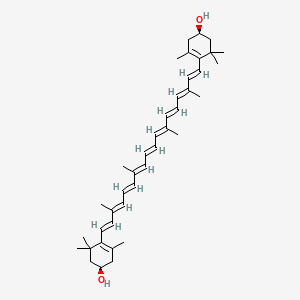| MeSH term | MeSH ID | Detail |
|---|---|---|
| Inflammation | D007249 | 119 associated lipids |
Zeaxanthin
Zeaxanthin is a lipid of Prenol Lipids (PR) class. Zeaxanthin is associated with abnormalities such as Disintegration (morphologic abnormality), Alkalemia, Age related macular degeneration, Visual impairment and Consumption-archaic term for TB. The involved functions are known as Signal, Regulation, Energy Transfer, Process and Pigment. Zeaxanthin often locates in Chloroplast thylakoids, reaction center, Tissue membrane, PSII associated light-harvesting complex II and Thylakoid Membrane. The associated genes with Zeaxanthin are PRB2 gene, Structural gene, Polypeptides, Genes, Bacterial and Genes, rRNA. The related lipids are Membrane Lipids, Micelles, Fatty Acids, Lipid Peroxides and monogalactosyldiacylglycerol. The related experimental models are Knock-out.
Cross Reference
Introduction
To understand associated biological information of Zeaxanthin, we collected biological information of abnormalities, associated pathways, cellular/molecular locations, biological functions, related genes/proteins, lipids and common seen animal/experimental models with organized paragraphs from literatures.
What diseases are associated with Zeaxanthin?
Zeaxanthin is suspected in Dermatitis, Phototoxic, Age related macular degeneration, Cataract, Disintegration, Reflex Epilepsy, Photosensitive, Dehydration and other diseases in descending order of the highest number of associated sentences.
Related references are mostly published in these journals:
| Disease | Cross reference | Weighted score | Related literature |
|---|
Possible diseases from mapped MeSH terms on references
We collected disease MeSH terms mapped to the references associated with Zeaxanthin
PubChem Associated disorders and diseases
What pathways are associated with Zeaxanthin
There are no associated biomedical information in the current reference collection.
PubChem Biomolecular Interactions and Pathways
Link to PubChem Biomolecular Interactions and PathwaysWhat cellular locations are associated with Zeaxanthin?
Visualization in cellular structure
Associated locations are in red color. Not associated locations are in black.
Related references are published most in these journals:
| Location | Cross reference | Weighted score | Related literatures |
|---|
What functions are associated with Zeaxanthin?
Related references are published most in these journals:
| Function | Cross reference | Weighted score | Related literatures |
|---|
What lipids are associated with Zeaxanthin?
Related references are published most in these journals:
| Lipid concept | Cross reference | Weighted score | Related literatures |
|---|
What genes are associated with Zeaxanthin?
Related references are published most in these journals:
| Gene | Cross reference | Weighted score | Related literatures |
|---|
What common seen animal models are associated with Zeaxanthin?
Knock-out
Knock-out are used in the study 'Zeaxanthin binds to light-harvesting complex stress-related protein to enhance nonphotochemical quenching in Physcomitrella patens.' (Pinnola A et al., 2013).
Related references are published most in these journals:
| Model | Cross reference | Weighted score | Related literatures |
|---|
NCBI Entrez Crosslinks
All references with Zeaxanthin
Download all related citations| Authors | Title | Published | Journal | PubMed Link |
|---|---|---|---|---|
| Young AJ and Frank HA | Energy transfer reactions involving carotenoids: quenching of chlorophyll fluorescence. | 1996 | J. Photochem. Photobiol. B, Biol. | pmid:8988608 |
| Gabrielska J and Gruszecki WI | Zeaxanthin (dihydroxy-beta-carotene) but not beta-carotene rigidifies lipid membranes: a 1H-NMR study of carotenoid-egg phosphatidylcholine liposomes. | 1996 | Biochim. Biophys. Acta | pmid:8972700 |
| Jyonouchi H et al. | Effects of various carotenoids on cloned, effector-stage T-helper cell activity. | 1996 | Nutr Cancer | pmid:8910913 |
| Enger SM et al. | Dietary intake of specific carotenoids and vitamins A, C, and E, and prevalence of colorectal adenomas. | 1996 | Cancer Epidemiol. Biomarkers Prev. | pmid:8833613 |
| Woodall AA et al. | Dietary supplementation with carotenoids: effects on alpha-tocopherol levels and susceptibility of tissues to oxidative stress. | 1996 | Br. J. Nutr. | pmid:8813904 |
| Seaton GG et al. | Novel amplification of non-photochemical chlorophyll fluorescence quenching following viral infection in Chlorella. | 1996 | FEBS Lett. | pmid:8766724 |
| Tardy F and Havaux M | Photosynthesis, chlorophyll fluorescence, light-harvesting system and photoinhibition resistance of a zeaxanthin-accumulating mutant of Arabidopsis thaliana. | 1996 | J. Photochem. Photobiol. B, Biol. | pmid:8765663 |
| Hammond BR et al. | Sex differences in macular pigment optical density: relation to plasma carotenoid concentrations and dietary patterns. | 1996 | Vision Res. | pmid:8759440 |
| Hammond BR et al. | Iris color and macular pigment optical density. | 1996 | Exp. Eye Res. | pmid:8690039 |
| Marin E et al. | Molecular identification of zeaxanthin epoxidase of Nicotiana plumbaginifolia, a gene involved in abscisic acid biosynthesis and corresponding to the ABA locus of Arabidopsis thaliana. | 1996 | EMBO J. | pmid:8665840 |
